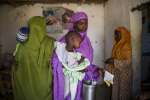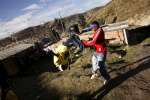UNHCR uses food to boost class attendance in camps for Angolans
News Stories, 19 November 2009
LUSAKA, Zambia, November 19 (UNHCR) – The UN refugee agency, with technical support from the World Food Programme (WFP), has embarked on a school feeding programme to increase classroom attendance and reduce malnutrition at two settlements for Angolan refugees in Zambia.
The programme was launched earlier this month in Meheba and Mayukwayukwa in north-western and western Zambia. The two settlements have a combined refugee population of about 25,000. Most buy or grow their own food, while WFP continues to assist some 3,000 of the most vulnerable.
The number of people still receiving food rations was cut from 15,000 last year to the current 3,000 in a bid to promote self-sufficiency among the refugees, many of whom have been living in the settlements for some four decades.
But UNHCR subsequently noticed a drop in school attendance as families weaned off the assistance sent their children out to help grow or search for food, rather than attend classes. Figures for 2008 showed total enrolment at 45-65 percent, depending on the time of year, and a drop-out rate of 10-25 percent.
There are currently some 3,500 children of school age in Mayukwayukwa and 5,500 in Meheba. But UNHCR figures show that only about 6,000 are regularly attending school. The aim is to ensure that all 9,000-10,000 children attend classes.
Under the programme, UNHCR has supplied stoves and kitchen equipment to 14 primary schools in Meheba and eight in Mayukwayukwa and will regularly deliver enough ingredients to provide one meal of porridge a day to 6,000 children. The programme is due to last six months but UNHCR hopes to find funding to extend this.
"We want to make sure all refugee children have access to education at all times and the provision of food will promote attendance at schools in the two settlements. This school feeding programme will also assist in improving the overall nutritional status of refugee children," explained Kristine Hambrouck, UNHCR's senior programme officer in Zambia.
"We have a lot of children coming forward," she said, while adding that drop-out rates were normally higher at this time of year, when the rainy season starts and there is little farming.
WFP has provided technical support, including the food procurement. It also facilitated the training of cooks from among the refugee community.
By Kelvin Shimo in Lusaka, Zambia















































